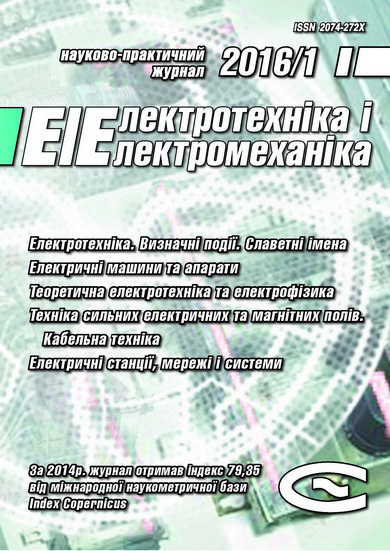NEURAL NETWORK MODELING IN PROBLEMS OF PREDICTION MODES OF ELECTRICAL GRIDS
DOI:
https://doi.org/10.20998/2074-272X.2016.1.12Keywords:
electric grid, neural grid, neuro-fuzzy grid, temperature monitoring of air electric line, prediction modes of electric gridAbstract
Purpose. Form a neuro-fuzzy network based on temperature monitoring of overhead transmission line for the prediction modes of the electrical network. Methodology. To predict the load capacity of the overhead line architecture provides the use of neuro-fuzzy network based on temperature monitoring of overhead line. The proposed neuro-fuzzy network has a four-layer architecture with direct transmission of information. To create a full mesh network architecture based on hybrid neural elements with power estimation accuracy of the following two stages of the procedure: - in the first stage a core network (without power estimation accuracy) is generated; - in the second stage architecture and network parameters are fixed obtained during the first stage, and it is added to the block estimation accuracy, the input signals which are all input, internal and output signals of the core network, as well as additional input signals. Results. Formed neuro-fuzzy network based on temperature monitoring of overhead line. Originality. A distinctive feature of the proposed network is the ability to process information specified in the different scales of measurement, and high performance for prediction modes mains. Practical value. The monitoring system will become a tool parameter is measuring the temperature of the wire, which will, based on a retrospective analysis of the accumulated information on the parameters to predict the thermal resistance of the HV line and as a result carry out the calculation of load capacity in real time.References
Naumov A.N., Vendrov A.M., Ivanov V.K. Sistemy upravleniia bazami dannykh i znanii [Database management systems and knowledge]. Moscow, Finansy i statistika Publ., 1991. 352 p. (Rus).
Kenneth C. Sevcik. Priority scheduling disciplines in queueing network models of computer systems. In Proceedings of IFIP Congress’77. August 8-12, 1977, Toronto, Canada, pp. 565-570.
V. Mainkar, K.S. Trivedi. Approximate analysis of priority scheduling systems using stochastic reward nets. In Proceedings of the 13th International Conference on Distributed Computing Systems ICDCS’93. May 1993, Pittsburgh, PA, USA, pp. 466-473. doi: 10.1109/icdcs.1993.287678.
Leonard Kleinrock. Queueing Systems. Volume 8: Computer Applications. John Wiley and Sons, New York, USA, 1976.
Popov S.V., Cheremisin M.M., Parkhomenko O.V., Shkuro K.A. Neural network method for predicting accidents due to formation of ice on power lines overhead. Visnyk Vinnytskoho politekhnichnoho instytutu – Visnyk of Vinnytsia Politechnical Institute, 2012, no.1, pp.161-163. (Ukr).
Popov S.V., Shkuro K.A., Cheremisin N.M., Parkhomenko O.V. A hybrid method of predicting ice load on power lines overhead. Enerhetyka ta elektryfikatsiia – Energetic and electrification, 2013, no.5, pp. 33-38. (Rus).
Kruglov V.V. Methods of forecasting multivariate time series. Pribory i sistemy. Upravlenie, kontrol', diagnostika – Devices and systems. Management, monitoring, diagnostics, 2005, no.2, pp. 62-66. (Rus).
Popov S.V., Shkuro K.A. Evolutionary neuro-fuzzy network based on hybrid neural elements. 17 mizhn. konf. z avtomatychnoho upravlinnia «Avtomatyka-2010». Tezy dopovidei [Proceedings of 17th Int. Conf. of Automatic Control «Automation 2010»]. Kharkiv (Ukraine), 2010, vol.2, pp. 193-194. (Rus).
Popov S.V. Specialized architecture of artificial neural networks based on hybrid neural elements. Zbirnyk naukovykh prats Natsionalnoho hirnychoho universytetu – The collection of scientific works of National Mining University, 2009, vol.2, no.33, pp. 76-82.
Titov N.N. Povyshenie nadezhnosti i kachestva funktsionirovaniia avtomatizirovannykh sistem dispetcherskogo upravleniia elektroenergeticheskimi sistemami [Improving the reliability and quality of the functioning of the automated systems of dispatching management of power systems]. Kharkov, Fakt Publ., 2013. 200 p. (Rus).
Downloads
Published
How to Cite
Issue
Section
License
Copyright (c) 2016 A. N. Moroz, N. M. Cheremisin, V. V. Cherkashina, A. V. Kholod

This work is licensed under a Creative Commons Attribution-NonCommercial 4.0 International License.
Authors who publish with this journal agree to the following terms:
1. Authors retain copyright and grant the journal right of first publication with the work simultaneously licensed under a Creative Commons Attribution License that allows others to share the work with an acknowledgement of the work's authorship and initial publication in this journal.
2. Authors are able to enter into separate, additional contractual arrangements for the non-exclusive distribution of the journal's published version of the work (e.g., post it to an institutional repository or publish it in a book), with an acknowledgement of its initial publication in this journal.
3. Authors are permitted and encouraged to post their work online (e.g., in institutional repositories or on their website) prior to and during the submission process, as it can lead to productive exchanges, as well as earlier and greater citation of published work.





